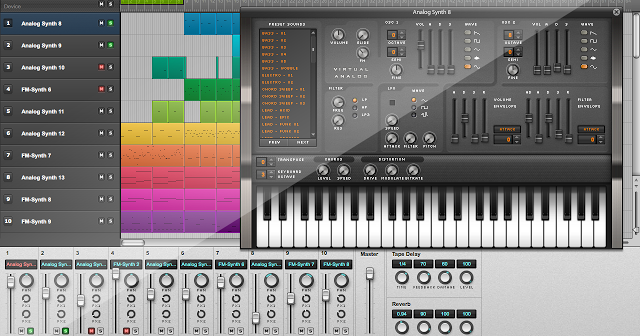

SoundRef tocSound = fn SoundWithContentsOfURL( soundURL, NO ) CFURLRef soundURL = fn BundleURLForSoundResource( fn BundleMain, ) Uncomment these lines to use an external sound file name toc.wave Local fn RunMetronome( bpm as CFTimeInterval ) Slider _slider, YES, _initialBPM, r, 20, 190, _windowĬolorwell _bpmIndicator, YES, fn ColorGreen, r, NO, _windowĬolorWellSetBordered( _bpmIndicator, NO )ĬFArrayRef tempo = moderato", moderato", = fn CGRectMake( 10, 460, 140, 22 )ĬontrolSetAlignment( i, NSTextAlignmentRight )ĬFRunLoopTimerRef t = (CFRunLoopTimerRef)fn AppProperty( )ĬolorWellSetColor( _bpmIndicator, fn ColorGreen ) Window _window, r, NSWindowStyleMaskTitled + NSWindowStyleMaskClosable + NSWindowStyleMaskMiniaturizable

Menu _mFile, -1, _mFile, _iClose, _mFile, _iClose, )ĬGRect r = fn CGRectMake( 0, 0, 200, 500 ) Uncomment next line to use external sound file, and make necessary adjustments in fn RunMetronome Prestissimo – even faster (200 bpm and over).Vivacissimo – very fast and lively (172–176 bpm).

Allegro – fast, quick, bright (120–168 bpm).Allegro moderato – not quite allegro (116–120 bpm).Allegretto – moderately fast (112–120 bpm).Andante moderato – between andante and moderato (92–112 bpm).Marcia moderato – moderately, a march (83–85 bpm).Andantino – slightly faster (80–108 bpm).Adagietto – slower than andante (72–76 bpm).Larghissimo – very, very slow (24 bpm and under).
#Audiosauna metronome free#
The free FB compiler is available on theīasic Tempo Markings from slowest to fastest:
#Audiosauna metronome code#
The code has been tested on Catalina (10.15.x) to Monterey (12.4.x) with Ventura still in beta at the time of this post. It's GUI includes a slider control to adjust speed, as well as blinking indicator and a sound, to indicate tempo.
#Audiosauna metronome mac#
' Sound Function v0.3 For DOS/Linux/Win by yetifoot ' Credits: ' ' # ifdef _FB_WIN32_ # include Once "windows.bi" # endif Sub Sound_DOS_LIN ( Byval freq As Uinteger, dur As Uinteger ) Dim t As Double Dim As Ushort fixed_freq = 1193181 \ freq Asm mov dx, & H61 ' turn speaker on in al, dx or al, & H03 out dx, al mov dx, & H43 ' get the timer ready mov al, & HB6 out dx, al mov ax, word Ptr ' move freq to ax mov dx, & H42 ' port to out out dx, al ' out low order xchg ah, al out dx, al ' out high order End Asm t = Timer While (( Timer - t ) * 1000 ) 0 Then Sound ( 100, 60 ) Color 10 : Print "tick " Else Sound ( 119, 60 ) Color 11 : Print "TICK " End If Sleep ( retardo ) Loop End Sub FutureBasic Īn Apple Mac application that, when compiled with FB, produces a packaged, stand-alone 64-bit application that will run on either Intel or the newer M-series Macs. REM La función Sound no es mía, incluyo los créditos correspondientes. REM FreeBASIC no tiene la capacidad de emitir sonido de forma nativa. Start at a slow practice tempo and gradually increase the tempo when you can play the piece without any mistakes.#include #include #include #include #include #include #include struct timeval start, last inline int64_t tv_to_u ( struct timeval s ) : metronome-ui ( bpm notes - ) "Metronome" open-window : metronome-example ( - ) metronome-defaults metronome-ui : validate-args ( int-args - ) map dup validate-args unclip swap : metronome-cmdline ( - bpm notes ) command-line get if-empty : print-defaults ( - ) metronome-defaults swap prefix interleave nl : metronome-usage ( - ) "Usage: metronome " print "Arguments must be non-zero" print "Example: metronome " write print-defaults flush : metronome-main ( - ) recover ] with-ui MAIN: metronome-main Increase the difficulty by setting the numbers to 1/1 (played/muted), 2/2, and 4/4 respectively. Play a piece you know well and keep the tempo in the muted bar. Activate the mute function at the bottom, and set the metronome to play 3 bars and mute 1 bar. Set the metronome to the indicated tempo, establish the tempo, and stop the metronome before you start playing. Find the tempo indicated in the score.You can always select 1 if you don't know the number of beats per measure. Most music has 4, 3 or 2 beats per measure, in music notation denoted by time signatures such as 4/4, 3/4, 2/4 and 2/2. Select the number of beats per measure at the bottom. Alternately, you can tap the tempo by clicking the "Tap tempo" button at the desired tempo or by using the "t" key on your keyboard. Start by selecting a tempo using the slider or, the left and right arrow keys on your keyboard. It is also used in live performances and recording studios to ensure an accurate tempo throughout the performance or session. A tempo marking of 60 BPM equals one beat per second, while 120 BPM equals two beats per second.Ī metronome is commonly used as a practice tool to help maintain a steady tempo while learning difficult passages. The pulse is measured in BPM (beats-per-minute). A metronome is a device that produces a steady pulse to help musicians play in time.


 0 kommentar(er)
0 kommentar(er)
